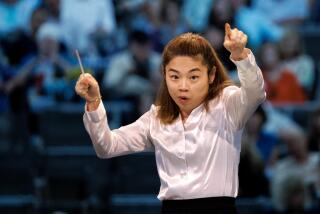MUSIC REVIEW : Rattle and Symphony Open Tour
The tables were turned Tuesday night when Simon Rattle and the City of Birmingham Symphony arrived at the Orange County Performing Arts Center to begin the orchestra’s first United States tour.
Leading this 100-member ensemble, of which he has been principal conductor and musical adviser since 1980, Rattle is the more accomplished practitioner on the musical team. Though the orchestra was founded in 1920, its players’ average age, according to Rattle, is actually less than his own (33).
For the record:
12:00 a.m. April 2, 1988 For the Record
Los Angeles Times Saturday April 2, 1988 Home Edition Calendar Part 6 Page 11 Column 1 Entertainment Desk 1 inches; 19 words Type of Material: Correction
Simon Rattle is the Los Angeles Philharmonic’s only principal guest conductor. He was incorrectly identified in Thursday’s Calendar.
Conversely, in his capacity as one of two principal guest conductors of the Los Angeles Philharmonic, Rattle is the junior member.
In the flattering acoustic of Segerstrom Hall, this reversal of roles proved intriguing.
Not yet a virtuoso ensemble, the City of Birmingham Symphony is nevertheless a highly accomplished one. One can fairly compare its current musical state to that of second-rank North American symphonic bodies like those of Seattle, Utah or Vancouver. Often unrefined of sound, with its separate choirs still in the process of development, the orchestra attacks tough scores gamely, exuberantly and successfully.
At this debut performance, Rattle, clearly eager to show off his own orchestra, challenged it with a generous and varied program devoted to Haydn’s Symphony No. 70, Sibelius’ Seventh Symphony, Stravinsky’s ballet-score, “Petrushka,” and Ravel’s “La Valse.”
With that engaging and omnivorous conducting style Southern California audiences have admired since his first appearance here, Rattle delivered energetic, fluid performances. For the most part, his players responded enthusiastically.
Still, weaknesses in ensemble--unaligned attacks and cutoffs, inconsistent unanimity of articulation--and balance surfaced all too often.
Haydn’s sometimes-neglected D-major Symphony, led by Rattle with his familiar combination of affection and impatience, offered many felicitous moments marred only by an unevenness of instrumental textures. Though the ensemble had been reduced in numbers, the upper strings, producing a vibrato-rich sound often one level louder than necessary, emerged more dominant and strident than the style can accommodate.
Stridence also became a problem in “La Valse,” wherein the soft passages needed to set up the climaxes never became quiet enough. At this point, apparently, the orchestra’s dynamic range remains more narrow than it must eventually become.
With that sure command which marks his Sibelius performances, Rattle made the murky Seventh Symphony an occasion of comprehensibility. And “Petrushka,” carefully delineated and exhilaratingly paced, brought out the best qualities in both orchestra and conductor.
By way of encore, the Birmingham forces offered Stravinsky’s “Scherzo a la Russe.”
For its debut appearance tonight at the Dorothy Chandler Pavilion of the Music Center, the symphony repeats the Sibelius and Stravinsky works on a program with Robin Holloway’s “Seascape and Harvest.”
More to Read
The biggest entertainment stories
Get our big stories about Hollywood, film, television, music, arts, culture and more right in your inbox as soon as they publish.
You may occasionally receive promotional content from the Los Angeles Times.










